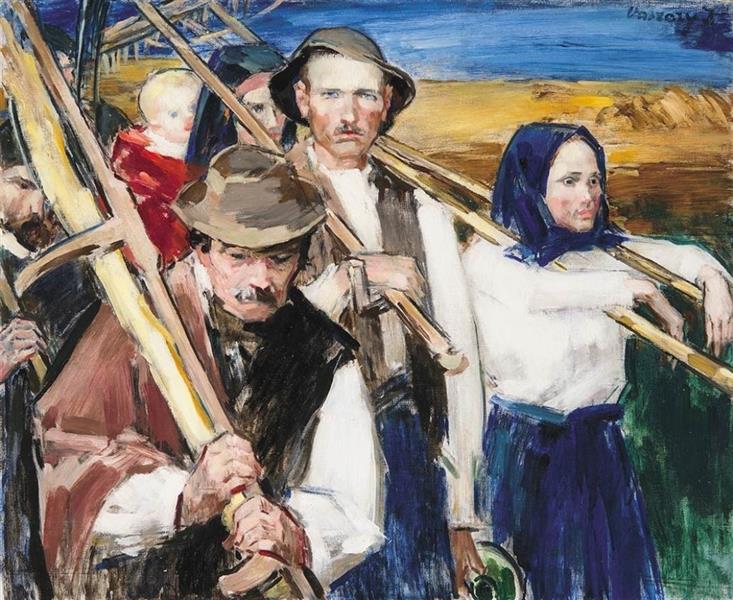Description
The painting "Aratók 1930" (harvesting 1930) by János Vascary is a vibrant and nostalgic testimony of rural life in Hungary. Vasaryry, an artist known for his versatility and adaptation to multiple styles throughout his career, offers us here a work that encapsulates the essence of peasant work through a composition whose simplicity hides a great wealth of details and emotions.
"Aratók 1930" is distinguished by its dynamic structure and its masterful use of color to transmit the energy and vibration of the scene. The work focuses on a group of harvesters in the field, active and focused on their work. Vigorous and loose strokes manage to capture the movement and effort of the characters, which, although schematic in their representation, transmit a powerful narrative of community and collective work.
One of the most notable aspects of the work is the color palette used. Vasaryy uses rich and warm tones dominated by the golden brown of the fields that contrast with the blue and green of the harvesting clothing, creating a balanced composition but full of chromatic tensions. The color is not only a beauty tool in this work, but a vehicle to transmit the strenuous heat of the sun that bathes the workers and the dust that surrounds them, wrapping the scene in an almost palpable atmosphere.
The arrangement of the characters in the painting reinforces the sense of community. The robust and angular bodies of the harvesters, while they are dedicated with fervor to the harvesting of the crops, seem almost merger with the earth they work, symbolizing a deep and ancestral connection with the ground. There are no superfluous details; Each line and color stain are placed with intention, highlighting Vasary's skill in the management of the composition and its understanding of the visual economy.
A look at the work also reveals the influence of postimpressionism and fauvism, movements of which Vascary borrowed the bold use of color and the ways to express moods and emotions, beyond the mere figurative representation. However, while fauvistas often sought emotional intensity through exaggerated distortions and amazing colors, Vasary maintains a balance, where the chromatic explosion serves the rural narrative without overflowing it.
The historical context of this work is also relevant to its understanding. Painted in 1930, in a period of political and economic turbulence in Europe, "Aratók 1930" can be read not only as a celebration of peasant life, but also as an evocation of the resistance and continuity of Hungarian culture and traditions in times of drastic changes.
János Vascary, belonging to a generation of artists who navigated between the initial impressionism and the avant -garde of the twentieth century, found in folk and ruralism an inexhaustible source of inspiration and reflection. "Aratók 1930" is a reliable proof of its ability to capture the authenticity of its environment and the spirit of its people, giving their work of a universality that transcends time and space.
In conclusion, "Aratók 1930" not only represents a daily scene of agricultural work, but through the style and technique of Vasary, becomes a window to the resilience and beauty of peasant life. The piece is a sublime example of art as a means to connect with cultural and human roots, and continues to resonate with a validity and humanity that challenges the chronology of its creation.
KUADROS ©, a famous paint on your wall.
Hand-made oil painting reproductions, with the quality of professional artists and the distinctive seal of KUADROS ©.
Art reproduction service with satisfaction guarantee. If you are not completely satisfied with the replica of your painting, we refund your money 100%.

